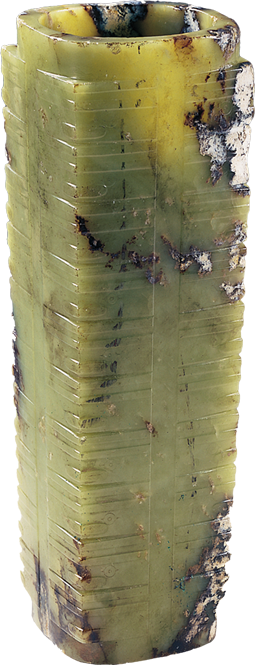Ten-Sectioned Jade Cong-Tube

Upper length 6.94 cm, lower length 6.3 cm, upper hole diameter 5.55 cm, lower hole diameter 5.14 cm, height 22.2 cm
Made of tremolite jade, the artifact is green and translucent, with extensive whitening on the surface due to calcium loss. The white patterns follow the natural fissures of the jade, accompanied by faint streaks of light black and gray-black granular spots. The cong has a rectangular column shape that is wider at the top and narrower at the bottom, with a circular through-hole that runs centrally, opening at both ends. It is divided into ten sections, each carved with simplified human face patterns. The face is indicated by a rectangular band incised with fine, parallel lines representing a headdress, while two circles of differing sizes (denoting the eyes and pupils) are drilled out. On a short horizontal panel, a geometric design reminiscent of swirling clouds signifies the nose, and above the hole a human figure is incised in relief, depicted with a long headdress, outstretched arms, flowing sleeves adorned with feather like decorations, and splayed legs as if in dance. The inner wall of the through hole is larger at both ends and narrower in the middle, formed by double sided drilling. Both interior and exterior surfaces are finely polished. The artifact holds significant historical, artistic, and scientific value for studying the jade processing techniques and the bronze civilization of the ancient Shu people in the Chengdu region during the Shang and Zhou dynasties.